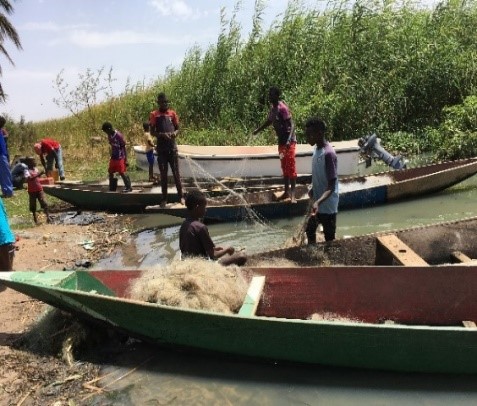
The ICCA of Lac de Guiers or Lake Guiers, located in Northern Senegal, covers an area of 3400 hectares of landscapes and seascapes. Its water bodies consists of two islets and five spawning grounds that are separated by four terrestrial enclaves formed by dunes and land composed of agricultural areas and local forests. Lac de Guiers is also designated as an Important Bird Area (IBA) by the Birdlife International (an International Organization Partner of the Ramsar Convention).
The ICCA has long suffered from the unsustainable practices of private sector companies (e.g. agribusiness companies) and of its neighboring local communities. Misuse of pesticides in agriculture, unregulated waste management and fishing in the frayere or spawning grounds have resulted to decreased quality of fish catch, agricultural unreliability and over-exploitation of species that form large spawning aggregations. Moreover, the typha proliferation in the lake compounds the food/water insecurity for people, livestock and birds being that it is an IBA and the main irrigation water source.
As such, the project Projet d’appui à l’APAC du Lac de Guiers seeks to restore and safeguard ecosystems, and protect livelihoods. The main project activity is the establishment of zones to separate and regulate fishing, spawning grounds, agriculture and pastoral activities. The zoning is aimed at safeguarding ecosystems and increasing the efficiency of their services for the wellbeing of communities, biodiversity conservation and social regulation. For example, with the food insecurity issues in the ICCA, two islands will be zoned for pastoral management. Following an ancient tradition, the cattle will stay in each island for 2-3 months, and migrate to the other island when food is gone. The sustainable practice of rotational grazing allows for regeneration, food security as well as conflict resolution between farmers and breeders when livestock invade farms. Establishing frayere zones will prohibit the exploitation of spawning components and the adverse impacts to its habitats.
Other important project components include: (i.) Capacity building in cleaning the river of typha; (ii.) Strengthening of the institutional, technical and financial capacities of ICCA communities; (iii.) Awareness-raising of peripheral communities on the importance of the ICCA to livelihoods and ecological balance through campaigns and radio infomercials provided by ICCA leaders; (iv.) ecological monitoring of fishes and migratory birds (as an IBA); and (v.) Establishment of a Support Fund for Environment and Development aimed at income-generating options (mostly for women) and the sustainability of project impacts.




